Standard [CURRENT]
ASTM E 2489:2021
Standard Practice for Statistical Analysis of One-Sample and Two-Sample Interlaboratory Proficiency Testing Programs
- Publication date
- 2021
- Original language
- English
- Pages
- 13
- Publication date
- 2021
- Original language
- English
- Pages
- 13
- DOI
- https://dx.doi.org/10.1520/E2489-21
Product information on this site:
Quick delivery via download or delivery service
Buy securely with a credit card or pay upon receipt of invoice
All transactions are encrypted
Short description
1.1 This practice describes methods for the statistical analysis of laboratory results obtained from interlaboratory proficiency testing programs. As in accordance with Practice E1301 , proficiency testing is the use of interlaboratory comparisons for the determination of laboratory testing or measurement performance. Conversely, collaborative study (or collaborative trial) is the use of interlaboratory comparisons for the determination of the precision of a test method, as covered by Practice E691 . 1.1.1 Method A covers testing programs using single test results obtained by testing a single sample (each laboratory submits a single test result). 1.1.2 Method B covers testing programs using paired test results obtained by testing two samples (each laboratory submits one test result for each of the two samples). The two samples should be of the same material or two materials similar enough to have approximately the same degree of variation in test results. 1.2 Methods A and B are applicable to proficiency testing programs containing a minimum of 10 participating laboratories. 1.3 The methods provide direction for assessing and categorizing the performance of individual laboratories based on the relative likelihood of occurrence of their test results, and for determining estimates of testing variation associated with repeatability and reproducibility. Assumptions are that a majority of the participating laboratories execute the test method properly and that samples are of sufficient homogeneity that the testing results represent results obtained from each laboratory testing essentially the same material. Each laboratory receives the same instructions or protocol. 1.4 This standard does not purport to address all of the safety concerns, if any, associated with its use. It is the responsibility of the user of this standard to establish appropriate safety, health, and environmental practices and determine the applicability of regulatory limitations prior to use. 1.5 This international standard was developed in accordance with internationally recognized principles on standardization established in the Decision on Principles for the Development of International Standards, Guides and Recommendations issued by the World Trade Organization Technical Barriers to Trade (TBT) Committee.
ICS
71.040.40
DOI
https://dx.doi.org/10.1520/E2489-21
Also available in
Loading recommended items...
Loading recommended items...
Loading recommended items...

